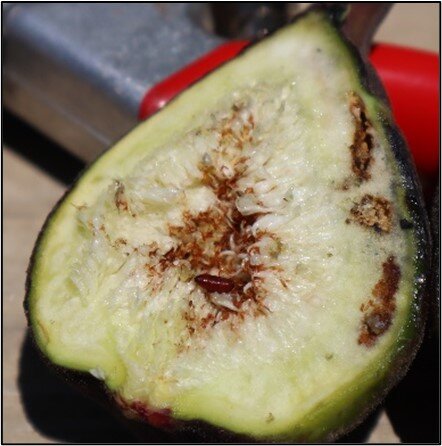New Pest Alert: Black Fig Fly
We previously shared a post written by Ben Faber on the Topics in Subtropics blog. We’re sharing a bit more information on where it has been located, how it may be monitored for, and additional damage and insect identification photos.
PEST ALERT – Black Fig Fly
(Diptera: Lonchaeidae: Silba adipata)
Invasive Fig Pest Recently Discovered in Southern California
Overview: Fig growers need to be aware of the black fig fly (BFF), an invasive insect that was recently discovered infesting figs in multiple counties in southern California. The BFF has been reported in the following counties: Los Angeles, Orange, Riverside, Santa Barbara, San Bernardino, San Diego and Ventura. Movement of figs from these counties is not recommended, as it may lead to additional artificial spread of BFF to other areas of the state. University of California Cooperative Extension personnel are currently working with the California Department of Food and Agriculture to further delineate populations, as well as develop improved monitoring and management strategies.
Figure 1. BFF female depositing eggs into the fig ostiole. Photo: H. Wilson your story online can make all the difference.
Life Cycle: The BFF only attacks figs and prefers unripe and unfertilized fruits. The adult female deposits eggs into the fruit through the ostiole (Figure 1) and larvae subsequently feed internally on the fruit (Figure 2). This feeding damages the fruit and causes it to prematurely drop from the tree. Upon completion of development, the BFF larvae make their way out of the fruit (Figure 3), drop to the soil and pupate. In some cases, BFF pupae have been recovered inside of fruits as well (Figure 4). Black fig flies overwinter as pupae in the soil. In the spring they emerge, mate and begin to attack figs. The BFF can have between 4 to 6 generations per year (more in warmer areas, fewer in cooler areas).
Figure 2. Internal damage to the fig from larval feeding.
Photos: H. Wilson
Figure 3. Exit hole from larva burrowing out of the fruit.
Figure 4. BFF pupa found inside of a fig.
Monitoring: Fig fruits can be inspected for signs of BFF activity, such as larval feeding or exit holes. Focus on unripe fruits that have recently fallen from the tree. Populations of BFF adults can also be monitored using McPhail-type traps (Figure 5) baited with torula yeast lures, although the efficacy of this trap/lure combination is still under evaluation.
Figure 5. McPhail-type trap. Photo: UC IPM
Management: Biological control appears to be limited and there are currently no chemical controls registered specifically for this pest on California figs. As such, orchard sanitation is critical, and growers should make sure to remove and destroy any BFF-infested fruits. Larvae in infested fruit are protected from pesticide sprays and there are no effective soil drenches for pupal control. Insecticidal baits (e.g. GF-120 NF Naturalyte®) may be useful for control of adult BFF but note that label rates have not been directly tested for efficacy against this pest. Consult with a licensed pest control adviser and your County Agricultural Commissioner before applying any chemical controls.
Please Do Not Move Figs: California figs are primarily grown in the Central Valley between Merced and Fresno, with many smaller orchards spread along the coast and in southern California. Movement of figs from the infested counties is not recommended, as it may lead to additional artificial spread of BFF to other areas of California.
Reporting the Pest: If you find infested fruit or suspect that BFF may be attacking fruits in your orchard or yard, please contact your local UCCE Farm Advisor and County Agricultural Commissioner. You can also report this pest to CDFA’s Pest Hotline: 1-800-491-1899 (https://www.cdfa.ca.gov/plant/reportapest/).
Contact Information: If you have any additional questions, please contact Houston Wilson (Houston.wilson@ucr.edu).
Authors: Houston Wilson (Dept. Entomology, UC Riverside), Kadie Britt (Dept. Entomology, UC Riverside), Phoebe Gordon (UC Cooperative Extension), Ben Faber (UC Cooperative Extension), and Sonia Rios (UC Cooperative Extension).





